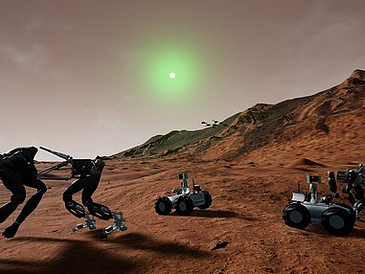The Computer Graphics working group headed by Professor Gabriel Zachmann at the Center for Computing Technologies (TZI) at the University of Bremen, the Cognitive Neuroinformatics working group headed by Professor Kerstin Schill, and the High-Performance Visualization (HPV) working group headed by Professor Andreas Gerndt are central to this. The VaMEx-3 project consists of four parallel subprojects with partners from all over Germany. It has a total funding volume of around five million euros.
Real-Time Simulation of Mars Exploration
In previous projects, the TZI scientists already virtually recreated some 40 square kilometers of Mars’s surface on the basis of NASA scans in order to establish a test environment for the required technologies. The project partners then deployed digital versions of their robot systems in this virtual twin of the real Mars landscape.
“So far, each swarm member acted largely on its own,” reports project coordinator Dr. René Weller from the Computer Graphics working group at TZI. “Now it’s all about bringing them together in a collaborative way.” Interfaces are intended to enable the different systems to interact in real time – and do so largely autonomously.
The test environment must meet the highest expectations: “The virtual twin must enable us to make realistic statements about whether the swarm will function in exactly the same way on Mars in the future,” emphasizes Professor Zachmann. The test environment must also allow us to identify existing weaknesses, for example if a robot is not yet sufficiently able to detect certain objects. For IT, it is a challenge to simulate all the vehicles quickly enough and, among other things, also to reproduce the camera images and lidar scans in real time.
Navigation without GPS, Galileo, or Paved Routes
While the Computer Graphics working group focuses on further developing the testing environment, the Cognitive Neuroinformatics working group is leading the subproject “Robust Ground Exploration,” a key point of which is the development of a common navigation method – because Earth’s satellite navigation system will be of no use on Mars. Software for that purpose is being developed at the University of Bremen. Moreover, the systems need to be made more robust in order to withstand difficult environmental conditions and deal with unexpected situations.
“One challenge is that – to a certain extent – the environment is unknown in advance,” explains Dr. Joachim Clemens, who is coordinating the subproject. “That’s why the swarm members have to identify obstacles themselves, create a map of their surroundings, and estimate their position on the map. And in doing that, the units cooperate with each other: map and positioning information is exchanged so that all units can benefit from it. The swarm participants then use this information to plan and coordinate their next steps.”
Another aspect of the subproject is the development and integration of a mission control tool. This system needs to enable both the visualization of the current mission status and the communication between the scientists and the VaMEx swarm. The information transmitted to the swarm, for example about scientifically relevant target areas, will be incorporated into the autonomous planning of the system and taken into account during the further course of the mission. The mission control tool is being developed by the High-Performance Visualization working group at the University of Bremen.
The Search for Water and Signs of Life
A major demonstration campaign is planned to extensively test the swarm of robots in a Mars-like testing area in three to four years’ time. The long-term goal of the VaMEx mission is to explore the Valles Marineris canyon system on Mars to find evidence of water resources and biological traces from eras on Mars that were more climatically conducive to hosting life. The Mariner Valleys, named after one of NASA’s first Mars space probes, form the largest canyon network in the solar system, stretching 4,000 kilometers and reaching depths of 10,000 meters in places.
In addition to the University of Bremen, the following partners are also involved in VaMEx-3: ANavS GmbH, the German Aerospace Center (DLR), DFKI Robotics Innovation Center, DSI Aerospace Technologie GmbH, INVENT GmbH, the Technical University of Braunschweig, the Technical University of Munich, the University of Erlangen-Nuremberg, the University of the Bundeswehr Munich, and the University of Würzburg.
Contact:
Dr. René Weller
Faculty of Mathematics / Computer Science
University of Bremen
Tel.: +49 421 218-63992
Email:
Further Information:
https://www.uni-bremen.de/en/tzi
http://www.cognitive-neuroinformatics.com/en/
www.uni-bremen.de/en/

